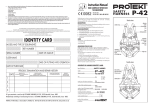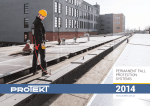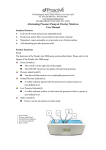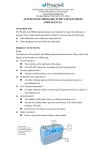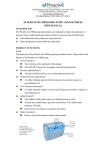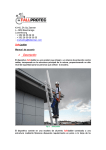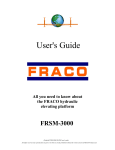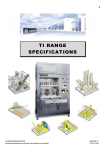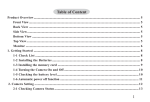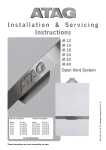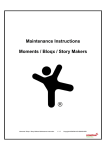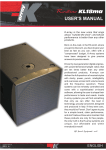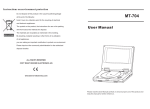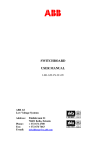Download guided type fall arrester ac080
Transcript
! ! ! ! ! ! anchor point (device) for fall arresting protective equipment should have a stable construction and the position, which limits the risk of fall and should minimize the free-fall distance. Anchor point of the equipment should be located above the user's workstation. The shape and design of the anchor point must provide for the permanent connection of equipment and must prevent from its accidental disconnection. It is recommended to use approved and designated anchor points for the equipment according to EN 795. Before using the device, It is mandatory to check the free space under the workstation, in which the personal protective equipment for arresting falls from a height is to be used, to avoid hitting the objects or the plane below while arresting the fall. The required free space under the workstation should be checked in read the instruction manual the user manual for protective equipment, which is to be used. While using the equipment, pay special attention to the dangerous phenomena affecting the operation of the equipment and the user's safety, in EN 353-2:2002 particular: EN 358:1999 - looping and moving the lanyard over sharp edges; EN 12841:2006 / A - swing falling; - current conduction; - any damage, such as cuts, abrasions, corrosion The AC080 guided type fall arrester is a component of personal protective equipment for arresting falls from a height, complying with the - the impact of extreme temperatures; following standards: EN 353-2, EN 358 and EN 12841. - negative impact of atmospheric factors; It is designed for use with textile core diameter ropes ø12mm. - impact of aggressive substances, chemicals, solvents, acids. The device is designed to protect one worker. Personal protective equipment must be transported in containers, which protect it from damage or getting wet, such as bags made of impregnated fabric or steel or plastic suitcases or boxes. CONSTRUCTION OF THE DEVICE Personal protective equipment must be cleaned and disinfected so as not to damage the material (raw material), which the device is made from . For textile material (straps, lanyard) use cleaning agents for delicate fabrics. Cleaned by hand or machine washing is permitted. Thoroughly DESCRIPTION OF THE DEVICE MARKING rinse. Parts made of plastic can be cleaned with water only. The components, which get wet while cleaning or during use of the equipment must An arrow indicating the correct be thoroughly dried in natural conditions, away from heat sources. Metal parts and mechanisms (springs, hinges, latches etc.) may be Coupling loop equipped positioning of the device on the lanyard with rope thimbles periodically lightly greased to improve their performance. Indication of the manufacturer UP Personal protective equipment must be stored loosely wrapped in a well ventilated dry place, protected from light, UV radiation, dust, sharp or distributor of the device 12 objects, extreme temperatures and corrosive substances. Type and diameter of the rope used EN 353-2:2002 EN 358:1999 Number and year of the European standard EN 12841:2006 Hole for unlocking type: A IT IS THE RESPONSIBILITY OF THE USER ORGANISATION TO PROVIDE THE IDENTITY CARD AND TO FILL IN THE DETAILS REQUIRED. the device Max. working load max. load: 120 kg THE IDENTITY CARD SHOULD BE FILLED IN BEFORE THE FIRST USE BY A COMPETENT PERSON, RESPONSIBLE INTHE USER ORGANIZATION FOR PROTECTIVE EQUIPMENT. Month (mm) / year (yyyy) of production ANY INFORMATION ABOUT THE EQUIPMENT LIKE PERIODIC INSPECTIONS, REPAIRS, REASONS OF EQUIPMENT'S WITHDRAWN FROM USE SHALL BE NOTED INTO THE IDENTITY CARD BY A COMPETENT PERSON. Date of manufacture: mm/yyyy Braided rope core THE IDENTITY CARD SHOULD BE STORAGED DURING A WHOLE PERIOD OF EQUIPMENT UTILIZATION. Serial No: 000 000 001 Serial number of the device DO NOT USE THE EQUIPMENT WITHOUT THE IDENTITY CARD. with a 12mm diameter ALL RECORDS IN THE IDENTITY CARD CAN BE FILLED IN ONLY BY A COMPETENT PERSON. CE mark and number of the notified body responsible for overseeing Aluminium the production of the device AC 080 clamping mechanism Instruction manual GUIDED TYPE FALL ARRESTER AC080 0082 IDENTITY CARD www.proverti.com MODEL AND TYPE OF EQUIPMENT Before use, please read and understand instructions for use REF. NUMBER Class B connector Catalogue number of the device DATE OF MANUF. SERIAL NUMBER USER NAME Locking plate for the mechanism on the lanyard DATE OF PUTTING INTO OPERATION DATE OF PURCHASE PERIODIC EXAMINATION AND REPAIR HISTORY DATE REASON FOR ENTRY PERIODIC EXAMINATION OR REPAIR DEFECTS NOTED, REPAIRS CARRIED OUT AND OTHER REVELANT INFORMATIONS NAME AND SIGNATURE OF COMPETENT PERSON PERIODIC EXAMINATION NEXT DUE DATE 1 2 3 4 PROTEKT ul. Starorudzka 9 93-403 Łódź www.proverti.com www.protekt.com.pl Notified body, at which the European certification was performed and which supervises the production of the equipment: APAVE SUDEUROPE SAS, BP 3 - 33370 ARTIGUES près BORDEAUX France, no. 0082 Safety knot PERIODIC INSPECTIONS At least once a year, after every 12 months of use, the AC080 device must be carefully inspected periodically. Periodic inspection may be carried out b y the person responsible in the workplace for the periodic inspection of protective equipment and trained in this area or by the manufacturer or a company, or a person authorized by the manufacturer. SERVICE LIFE AND MANUFACTURER'S INSPECTION The AC080 guided type fall arrester should be withdrawn from service and sent to the manufacturer in order to assess further fitness, if more than 5 years have passed from the date of first release for use, in order to carry out the manufacturer's inspection. Manufacturer's inspection may be carried out b y the manufacturer of the device or a company or a person authorized by the manufacturer. During the manufacturer's inspection, the service life of the fall arrester until the next manufacturer's inspection shall be specified. Anchor rope should be withdrawn from service and destroyed after 5 years of use. The AC080 device (clamping and sliding mechanism, rope and connectors) should be withdrawn from service and destroyed (physically destroyed), if the system has been used in arresting the fall. Before each use of the fall arresting equipment, which includes the AC080 device, check that all devices are correctly connected and work cooperate without any interference, as well as they are compatible with current standards: - EN 361 Full body harnesses - EN 362 Connectors - EN 358 Belts for work positioning and restraint and work positioning lanyards - EN 813 Sit harnesses - EN 795 Anchor devices. CONNECTING THE AC080 DEVICE WITH HARNESS WHEN USED AS GUIDED TYPE FALL ARRESTER WITH SELF-TIGHTENING GUIDE COMPLIANT WITH EN 353-2 Attach EN 795 the lanyard from the side of the loop with a thimble to the point of solid structure using an approved connector EN 362 Close the front side to block the mechanism on the lanyard, move the locking plate towards the lanyard (Fig. 2) 2 Fig. B A A L Anchor point, to which the lanyard is attached, should be placed above the user, its shape and structure should prevent the disconnection from the lanyard's disconnection. Anchor point must comply with the EN 795 requirements and have a minimum static strength of 10 kN. Avoid any overhangs of the lanyard between the user and the anchor point. Fig. C Under the user leave free space determined by the variables (Fig. C) depending on the length of the lanyard's section above the user - see table: Lanyard section above the user [m] - L Free space under the user [m] - X 10 20 30 40 2,80 4,00 5,20 6,40 Fig. D max. 45 o 50 7,80 NOTE: When ascending and descending the first 2 metres, the user may be not protected from hitting the ground and must observe extreme caution at this height. X A deviation of the lanyard from the vertical plane of max. 45° is permitted, when the user moves away (moving in the horizontal plane) from the point of solid structure (Figure D). Fig. F USING THE AC080 DEVICE AS ACCESS ROPE COMPLIANT WITH EN 12841 The AC080 device (used as an access rope) carrying the full weight of the user becomes a work rope and for safety reasons it requires using an additional device to arrest falls Fig. E. Any overload or dynamic load of the clamping mechanism may damage the lanyard. To unlock or offload the device on the lanyard, move the locking plate toward the lanyard. Place the connector in the unlocking hole and pull toward the free end of the lanyard Fig. F. Fig. E AC080 device used as an access rope EN 12841 EN 362 EN 358 EN 362 Attach the connector of the device to the central buckle of the sit harness or to one of the belt's buckles harness or the buckle of the work positioning belt. Attach the lanyard's connector to the anchor point. EN 813 EN 362 The AC080 guided type fall arrester should be used along with the belt for work positioning compliant with EN 358 or with sit harness compliant with EN 813. The elements of the solid structure or anchor points, to which it is attached, should be at the user's waist level and have the shape and structure preventing the disconnection of the lanyard. The tension and the length of the lanyard should be adjusted to restrict the distance of the free fall to the max. 0.6 m. Once the required length of the lanyard is established, lock the device on the lanyard using the locking plate Fig. A. To connect the AC080 device, use the 110mm class B connector according to EN 362. All connectors should be locked during operation and secured against accidental opening and disconnection of the locking mechanism. Do not attach additional element between the connector of the AC080 device, and the buckle of the belt or harness. Ensure that the free end of the connecting lanyard is equipped with a safety node to prevent the device's sliding off the lanyard. The AC080 device used for arresting the fall should be attached only to the cogging point of the harness compliant with EN 361. The cogging point must be marked with letter 'A' Fig. B To connect the AC080 device, use the 110mm Class B connector compliant with EN 362. During operation all connectors should be closed and secured against accidental opening and disconnection using a locking mechanism. Do not attach additional elements between the connector of the AC080 device, and the cogging point of the harness. Make sure that the free end of the lanyard has a safety node to prevent the device's sliding off the lanyard. 2 free end of the lanyard with a knot security 36 "A" - EN 361 connect the sides of the device with a approved Class B connector Attach the connector of the device to one side buckle of the work positioning belt. Gird the lanyard of the device around the element of the solid structure. Attach the lanyard's connector to the second side buckle. EN 2/B arrow on the side of the device should be directed towards the loop with a thimble to which a approved connector should be attached 1 36 insert the lanyard into the mechanism An arrow on the side of the device should be facing upwards towards the lanyard's anchor point EN 362 Fig. A Connect the sides, then attach the device to the connecting point cogging of the harness using an approved Class B connector EN Open the front side CONNECTING THE AC080 DEVICE WITH THE BELT FOR WORK POSITIONING AND RESTRAINT/ SIT HARNESS AS THE WORK POSITIONING AND FALL ARRESTING DEVICE ACCORDING TO EN 358 Guided type fall arrester compliant with EN 353-2 NOTE: The AC080 guided type fall arrester is not a device used for arresting the fall. In case of a risk of falling from a height, additionally use independent fall arresting system compliant with EN 363. GENERAL RULES FOR THE USE OF PERSONAL PROTECTIVE EQUIPMENT ! Personal protective equipment should be used only by people trained to use it. ! Personal protective equipment cannot be used by people whose health condition may affect the safety during daily use or during rescue operations. ! Prepare a rescue plan that can be applied, if required. ! Any modifications to the equipment without written permission are prohibited. ! Any repairs to the equipment can be carried out only by the manufacturer or an authorized representative. ! Personal protective equipment cannot be used for the purposes other than its intended purpose. ! Personal protective equipment is the personal equipment and should be used by one operator. ! Before use, ensure that all elements of the equipment of the fall arresting system cooperate with each other correctly. Periodically check the connections and matching of the components of the equipment to avoid its loosening or accidental disconnection. ! The use of protective equipment systems, in which the functioning any hardware component is disturbed by the action of another is prohibited. ! All elements of the personal protective equipment for arresting the falls from a height must be in accordance with relevant regulations and instructions for use of equipment, as well as relevant standards: ! - EN 361 full body harnesses ! - EN 353-1, EN 353-2, EN 354, EN 355, EN 360, EN 362 fall arresting systems ! - EN 795 Anchor devices (solid structure points) ! - EN 358 work positioning systems ! Before each use of personal protective equipment, carry out thorough visual inspection to check its condition and proper operation. The device shall be inspected by its user. ! During inspection, check all hardware components, paying particular attention to any damage, excessive wear, corrosion, abrasions, cuts and malfunction. Attention must be paid in each device: - in safety straps and work positioning belts: inspect buckles, adjustment elements, attachment points (buckles), straps, stitching, belt loops; - in energy absorbers: attachment loops, straps, stitching, housing, connectors; - in lanyards and textile guides for lanyards, loops, thimbles, connectors, adjustment elements, splicing; - in cables and steel guides: lanyard, wire, clamps, loops, thimbles, connectors, adjustment elements; - in retractable type fall arresters: lanyard or strap, correct functioning of the take-up reel and locking mechanism, housing, energy absorber, connectors; - in guided type fall arresters: device's body, correct sliding over the guide, the functioning of the locking mechanism, rollers, bolts and rivets, connectors, safety shock absorbers; - in connectors (snap hooks): load-bearing body, riveting, main trigger, the functioning of the locking mechanism. ! At least once a year, after 12 months of use, the personal protective equipment must be withdrawn from use for thorough inspection. Periodic inspection may be carried out by the person responsible in the workplace for periodic inspections of protective equipment and trained in this area. Periodic inspections may be carried out also by the hardware manufacturer or a person or a company authorized by the manufacturer. Thoroughly inspect all the equipment's components, paying particular attention to any damage, excessive wear, corrosion, abrasions, cuts, and malfunction (see previous section).In some cases, where protective equipment is a complicated and complex structure, such as retractable type fall arrester, periodic inspections may be carried out only by the equipment manufacturer or its authorized representative. Following the periodic inspection, a date of the next inspection shall be specified.



